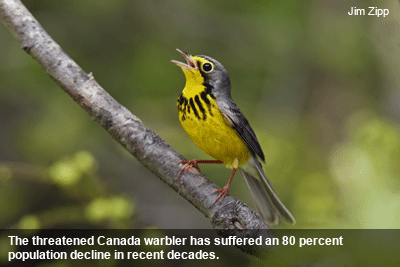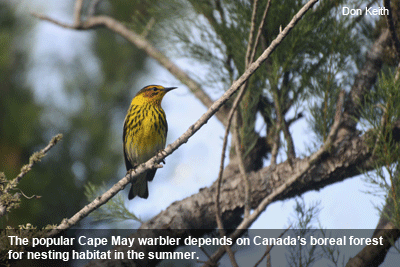Preserving North America's Bird Nursery
With spring migration in full flight, a new report urges greater protection for an avian haven.

It's been dubbed North America's bird nursery: the sprawling billion-plus-acre boreal forest that spans the continent from Alaska across Canada to Newfoundland and Labrador.
Each spring, an estimated 1 billion to 3 billion nesting birds make the long journey north to the boreal forest from wintering grounds throughout the United States and central and South America.
Their populations swell during the boreal breeding season, and as many as 3 billion to 5 billion birds of remarkable diversity—from ring-necked ducks to whooping cranes to Cape May warblers to golden eagles—can make the return trip south in the fall.
These are the birds that populate America's backyards, parks, and wetlands, providing enjoyment and recreation to millions of birders, conservationists, and waterfowl hunters.
But as abundant as they are, boreal birds face myriad challenges and threats to their habitat. Some of the most iconic species have suffered dramatic declines in recent decades.
To mark International Migratory Bird Day on May 10, a new report highlights the urgent need to protect North America's boreal forest, a still-pristine haven for more than 300 avian species and one of the planet's last great wilderness regions.
The report, Boreal Birds Need Half (PDF), cites science showing that boreal bird species require expansive, landscape-scale habitat conservation in large, interconnected protected areas to maintain healthy populations.
It showcases the often-unappreciated role that boreal birds play in providing ecosystem services by pollinating plants, redistributing nutrients, and controlling pests, as well as the value they add to the U.S. and Canadian economies. The report also emphasizes the integral role that birds play in the cultures of First Nations aboriginal peoples.
“The good news is that the boreal forest is still largely intact. The majority of birds that breed in the boreal forest still have large population sizes and are doing well,” said Jeff Wells, senior scientist at the Boreal Songbird Initiative and co-author of the report.
“But there are some birds—especially those breeding in the southern part of the boreal forest in Canada where there is a bigger industrial footprint—that have seen declines of 50 percent or more over the last 30 years,” Wells said.
The report recommends:
- That at least 50 percent of the boreal forest remain free of large-scale industrial disturbance, a protection level needed to ensure a high probability of maintaining the full spectrum of boreal birds.
- That industrial activity in the remaining unprotected areas be subject to the highest global sustainability standards, with an emphasis on maintaining healthy and pristine wetlands and waterways.
- That protected areas and industrial activities proceed only with the free, prior, and informed consent of aboriginal communities.
Boreal Birds Need Half was produced by the Boreal Songbird Initiative and Ducks Unlimited, partners with The Pew Charitable Trusts in the International Boreal Conservation Campaign.

Steve Kallick, director of international lands conservation at Pew, said the report demonstrates the benefits that boreal birds bring to people and ecosystems through the Western Hemisphere. Pew supports the report's recommendations.
“Birds don't have any boundaries. North America's boreal birds are a shared international responsibility,” said Kallick. “Not only do these birds have ecological value far beyond their breeding grounds, they bring joy to serious and casual bird lovers alike—no matter if it's in a northern First Nations community in Canada, in Central Park in Manhattan, or on the shores of Lake Michigan in Chicago. We have to give back to them by protecting their habitat.”
The report focuses on boreal bird populations in Canada, which contains the vast majority of the continent's boreal forest, and showcases important species and the key ecosystems they populate in nine provinces and territories.
According to Wells, the boreal's status as one of the planet's largest remaining intact forest ecosystems provides Canadian governments with a unique conservation opportunity not available in nations where wild places no longer exist on such a grand scale.
“What most of the world is trying to do is protect the remnants of the rare,” Wells said. “In the boreal region of Canada and Alaska and a few other parts of the world like the Amazon, there are still these large intact primary forests. It's not about trying to restore degraded habitats; it's about maintaining these pristine areas now, before you have to worry about saving remnants of the rare.”
The North American boreal forest is indispensable habitat for more than 300 species of birds, which rely on it for nesting or migratory stopover. The boreal is also a breeding ground for more than half the populations of nearly 100 species.
While many populations thrive, some of the best-known boreal songbird species—such as the olive-sided flycatcher, evening grosbeak, Canada warbler, and rusty blackbird—have lost more than two-thirds of their numbers. Among waterfowl, scoter populations have fallen by more than 80 percent and scaup by more than 50 percent.
“Scientists have come to understand that you need to protect at least 50 percent of an ecosystem to have the highest probability of maintaining the full suite of biodiversity,” Wells said. “Birds have those same needs.”











